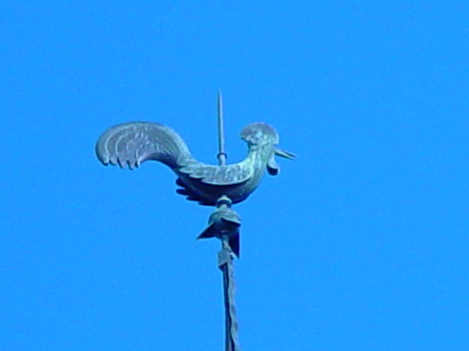


Weather vane which is designed to always point into the wind
|
|
||||||||
|
| ||||||||
|
Flight stability is governed by the relative positions of the centers of mass Cm and the aerodynamic center Ca. Some simple experiments:
|
||||||||
|
||||||||
|
Unstable flight of a plastic bottle.Take a plastic bottle without fins fill approximately one third full with water and pressurize with compressed air using one of the launching methods mentioned in the launching systems section. Make sure that the launch site is cleared before launch.
video of Unstable flight of 1.5 l bottle without fins or modified center of mass Unstable Image sequence71 > 120
Above you can see a photograph of both Cm and Ca centers that have been found for a simple 'Badoit' bottle without fins and nose cone. Note: The neck of the bottle and the equivalent datum of the flat card profile have then been set to the same reference datum before the photograph was taken.
The center of mass has been marked on the bottle by a black spot in the middle of a white ring.
Whilst an approximation of the aerodynamic center Ca can be seen marked onto a piece of stiff card. That has been cut out to the exact profile of the bottle. Note that for the normal bottle the center Ca is above the Cm. So in this configuration the bottle would be unstable. When launched as a rocket or as a projectile towards the right of the screen. |
||||||||
Stable flight of a plastic bottle
Manufacture a dynamically stable rocket from the same bottle fill with exactly the same volume of water and launch using the same method as used for Exp3. Manufacturing a dynamically stable rocket.
This can be done by suspending the rocket from a looped thread as seen in the photographs and changing the position of the cord until the bottle rests horizontal.
Objective: The ideal is for the position of the center of mass Cm to be one rocket body diameter above the Ca (aerodynamic center:) This condition will cause the aerodynamic forces to trail behind the center of mass and stabilise the flight path during its climb into the atmosphere. A dynamic couple is created that stabilises flight trajectory. An example of this is that we have carried out over 100 flights without parachute that have landed within a radius of 20m and attained apogee where the rocket has disappeared from sight.250m+
|
||||||||
|
Conditions that do not conform :
Solutions to make these conditions conform to our objective are:
|
||||||||
|
The weather vane
So why does a weather vane always face into the direction of the wind? Note that the vertical axes about which the weather vane pivots is forward of the center of the cock. This will coincide with the center of mass of the bird which is a hollow structure and is usually fabricated out of corrosion resistant metal sheet. Note: The head of the bird will be loaded whilst the tail will be hollow to bring the center of mass forward.
Next look at the large surface area of the tail of the bird relative to the neck and head. This will guarantee that the aerodynamic center or center of pressure is behind the pivot. You can try to imagine this as a large single fin. The air-stream passing over the surface of the bird produces a resultant force acting through the center of pressure that produces a couple (or turning moment ) about the vertical axis of the weather vane. Causing the head of the bird to turn into the direction the air-stream or wind. The above example of a rocket suspended from a thread placed above its center of mass turns into the direction of the air-stream in the same manner.
|
||||||||
|
Aerodynamic Ratio Effect For a given volume the ratio of length to diameter is important. L/D
Another experiment using helium filled balloons having the same volume of helium but balloons with different L/D ratios. That are released within a large internal space such as a sports hall and timed to determine which balloon has the fastest rate of climb. Height divided by time. Then discuss why there is a difference and what parameters could contribute. Objectives:
By inflating a stable large cross section parachute
|
||||||||
|
|
||||||||
|
Another parameter that is important is that the directional stability of the jet impulse is constant. We have assumed that the jet stream flowing from the nozzle of the stabilised rocket is constant and along the longitudinal axis of the rocket. That is the nozzle is fixed along the longitudinal axis of the rocket and symmetrical.. |
||||||||
|
Safety Note: Variable direction expansion nozzles can be used to vary the flight trajectory profile. It is not recommended to experiment with these until you have experienced a lot of successful launches with fixed nozzle rockets. Random flight direction stability similar to the balloon experiment can be expected. Remote launching is essential for testing variable direction nozzles. Test on a remote test range with experienced adult supervision The potential launch instability can be very dangerous. Please avoid the temptation to try these. Stick to the basics. All will come to those with the patience to be thorough. Develop ideas using static tests to confirm the directional stability of expansion nozzles before test launching. |
||||||||
04/05/06
This site was created on the 15th April 2003
ŠJohn Gwynn and sons2003
You're welcome to reproduce any material on this site for educational or other non commercial purposes
as long as you give us proper credit (by referring to "The Water-Rocket Explorer" http://waterocket.explorer.free.fr).